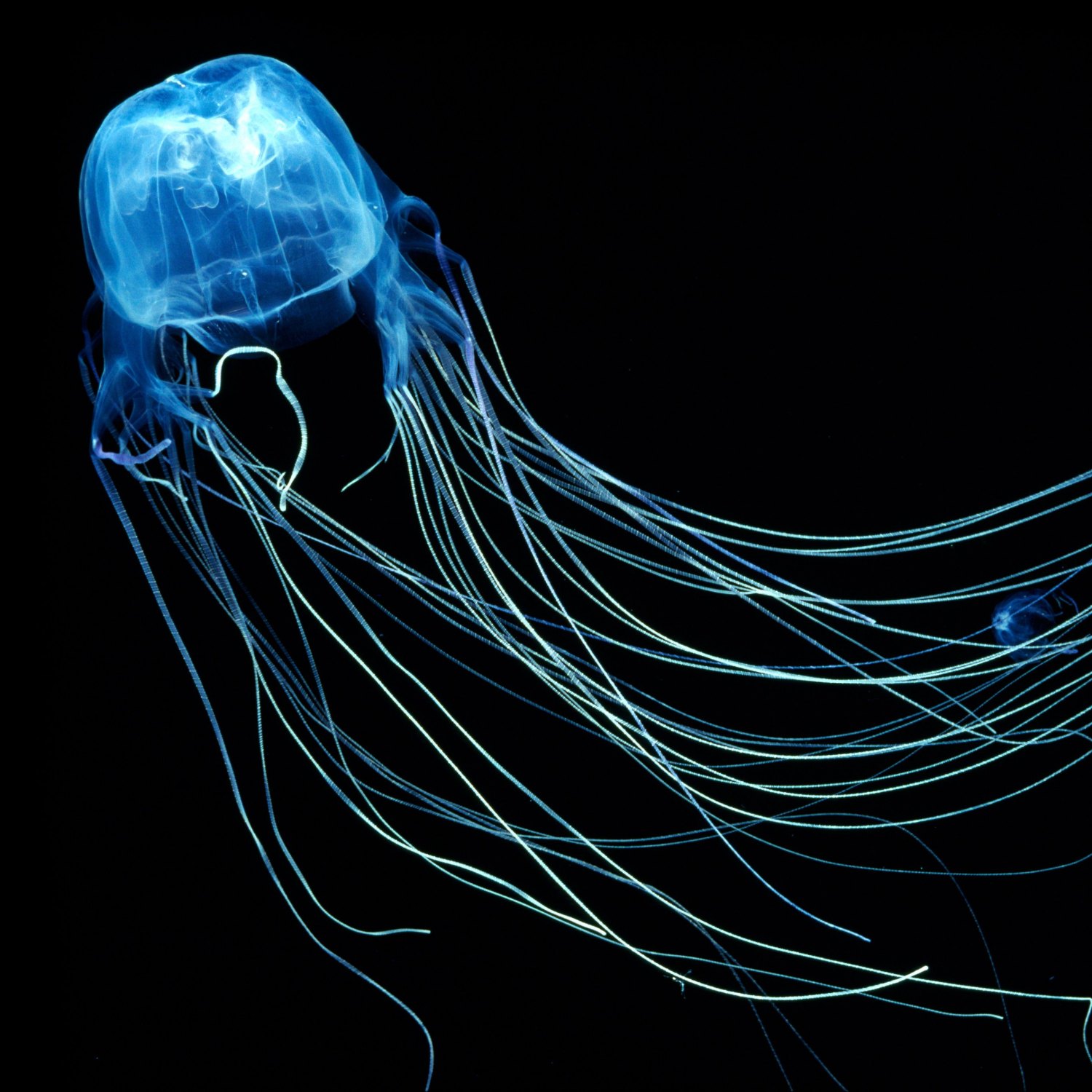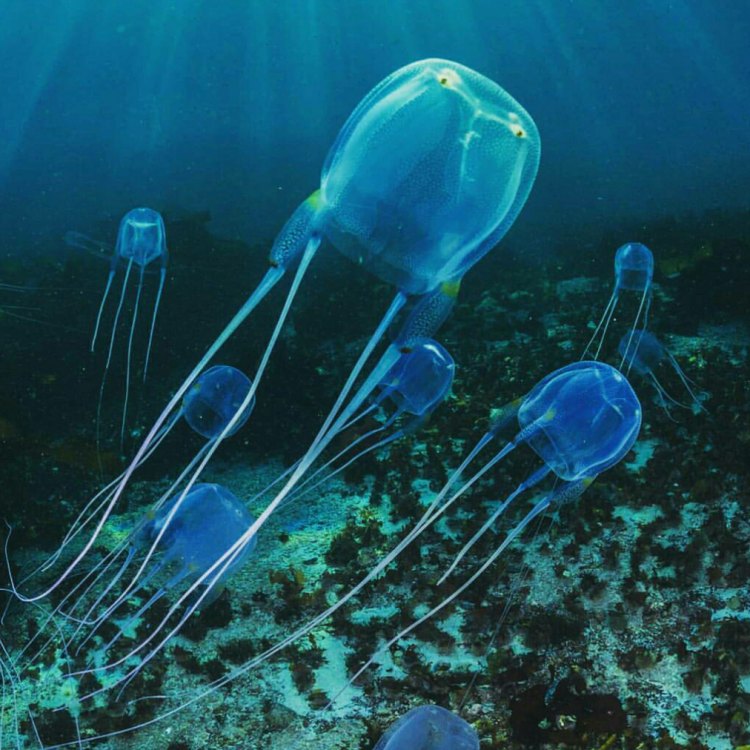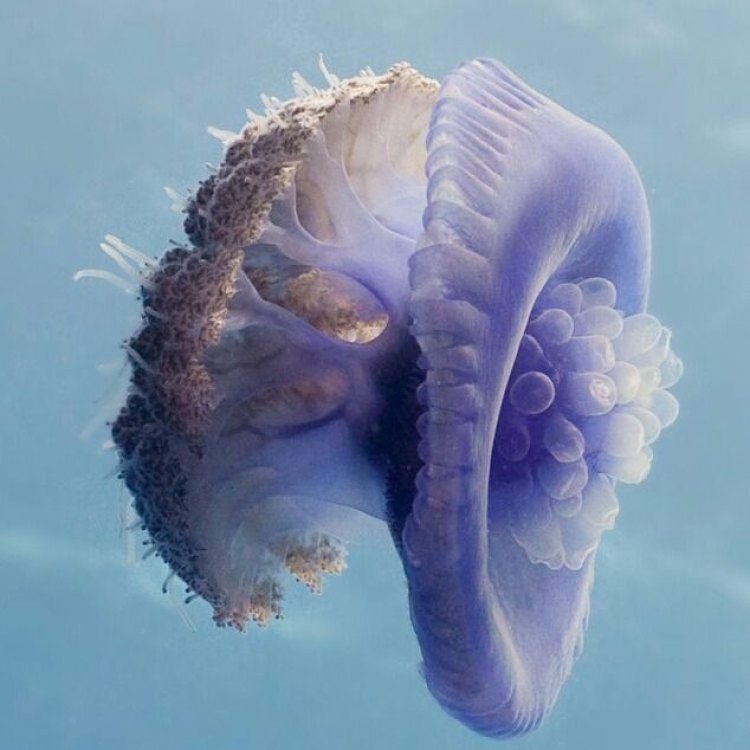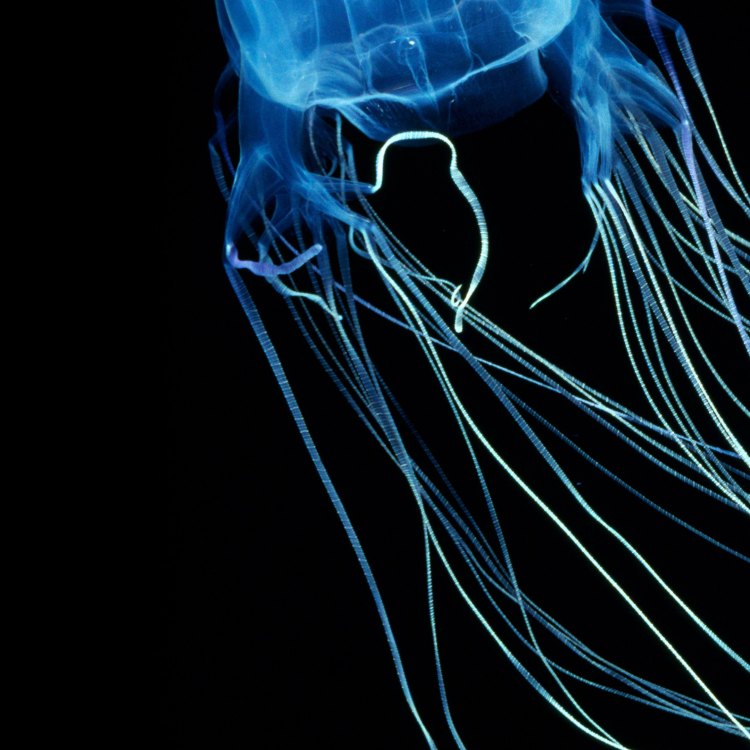
Box Jellyfish
Up to 30 cm
Box Jellyfish, known for their venomous stings, are a stunning species found in the Great Barrier Reef. They can grow up to 30 cm and belong to the Chirodropidae family. With their distinct bell-shaped body, these creatures are best admired from a distance. Explore and learn more about these fascinating animals in their natural habitat. #GreatBarrierReef #BoxJellyfish #Chirodropidae #marinecreature
Animal Details Summary:
Common Name: Box Jellyfish
Kingdom: Animalia
Habitat: Ocean
The Mysterious and Deadly Box Jellyfish: Exploring the Secrets of the Ocean's Most Feared Creature
The ocean is a vast and mysterious world, filled with an incredible variety of creatures. Some of these creatures are known for their beauty and grace, while others have gained a reputation for being dangerous and deadly. And one of the most notorious of these creatures is the box jellyfish.Despite its small size, the box jellyfish (scientific name: Chironex fleckeri) has earned a fearsome reputation for its potent venom and its deadly attacks on unsuspecting swimmers Box Jellyfish. But there is more to this mysterious creature than meets the eye. In this article, we will delve into the incredible world of the box jellyfish and discover what makes it such a unique and fascinating creature.
The Basics of the Box Jellyfish
The box jellyfish, also known as the sea wasp or marine stinger, is a member of the phylum Cnidaria, which includes other creatures such as corals and sea anemones. It belongs to the class Cubozoa, a group of jellyfish with box-like body shapes and distinct eye-like structures on their bell-shaped bodies. The box jellyfish's scientific name, Chironex fleckeri, is derived from the Greek words "chiron", which means hand, and "ex", which means outside, referring to the jellyfish's tentacles which resemble fingers hanging from its bell-shaped body.
This incredible creature is found in the ocean's tropical and subtropical waters, with its largest population found in Australia, particularly in the Great Barrier Reef. Its habitat is mainly in the ocean, where it can be found in both shallow and deep waters. The box jellyfish is a carnivorous predator, using its venomous tentacles to catch and paralyze its prey, which primarily consists of small fish and crustaceans.
The Unique Appearance of the Box Jellyfish
One of the most distinctive features of the box jellyfish is its transparent or translucent body Blackfin Tuna. This transparent appearance is due to a lack of pigmentation in its skin, making it almost invisible in the water. This characteristic also allows the box jellyfish to easily blend in with its surroundings, making it difficult for its prey to spot and avoid.
But what truly sets the box jellyfish apart is its body shape. Unlike other jellyfish, it has a box-like shape with four sides and a distinctive bell-shaped dome on top. This unique body shape gives the jellyfish its scientific name of Cubozoa, meaning "cube animals."
The Lethal Venom of the Box Jellyfish
One of the most notorious characteristics of the box jellyfish is its venom, which is one of the most potent toxins produced by any creature on the planet. Its venom contains toxins that can cause severe damage to the nervous system, heart, and skin.
The box jellyfish has an elaborate and sophisticated venom delivery system, with up to 15 tentacles on each corner of its body. These tentacles can reach up to three meters in length and carry thousands of tiny venom-filled capsules called nematocysts. When triggered, these nematocysts release toxins into their prey, causing paralysis and death.
While the venom of the box jellyfish is potent enough to kill a human, its effects may vary depending on the individual's size and health. For those who are stung, the pain can be excruciating, and may even lead to a cardiac arrest, making the box jellyfish one of the most feared creatures in the ocean.
Deadly Encounters with the Box Jellyfish
Unfortunately, encounters with the box jellyfish can be fatal. In Australia alone, at least 16 fatalities have been attributed to box jellyfish stings in the past 100 years. The majority of these deaths were caused by the Australian box jellyfish (Carukia barnesi), which is a smaller but equally venomous species. This species is known to swarm in massive numbers, making them an even more significant threat to humans.
But the most famous and deadliest encounter with the box jellyfish happened in the Philippines in 1958, where over 80 people were stung in just a few days. This event was known as "the great box jellyfish panic," and it sparked an intense interest in the scientific community to find a way to protect people from this deadly creature.
Uncovering the Mystery of the Box Jellyfish
Despite their fearsome reputation, there is still a lot we don't know about the box jellyfish. Scientists are continually studying these creatures in an effort to unlock their secrets and understand how their venom works.
One of the most significant findings in recent years is the discovery of a new type of minuscule eyes on the bell-shaped body of the box jellyfish. These are called "clarity" eyes, and they are responsible for the box jellyfish's ability to detect objects and navigate in the water. This discovery has shed new light on the box jellyfish's incredible hunting abilities and has opened up new possibilities for further research.
Protecting Ourselves from the Box Jellyfish
Due to the box jellyfish's deadly nature, many people are understandably wary of swimming in areas where they are known to inhabit. But with the growing popularity of water sports and beach activities, it is essential to learn how to protect ourselves from these creatures.
One common advice is to avoid swimming in areas known to have box jellyfish or to swim during the day when these creatures are more visible. Wearing protective clothing such as a lycra suit or a wet suit can also help reduce the risk of getting stung.
In addition, there have been significant advancements in research and technology to develop effective antidotes for the box jellyfish's venom. One example is the "stinger suit," designed by an Australian scientist, which is now used by lifeguards to protect them from potential box jellyfish stings.
The Fascinating World of the Box Jellyfish
While the box jellyfish may have a fearsome reputation, there is no denying its incredible and fascinating nature. Its unique appearance and potent venom have captured the interest and curiosity of scientists and researchers around the world, making it one of the most studied creatures in the ocean.
The box jellyfish serves as a reminder of the diverse and mysterious world that lies beneath the waves. And as we continue to uncover its secrets, we must also learn to coexist with these incredible creatures to protect both ourselves and them.

Box Jellyfish
Animal Details Box Jellyfish - Scientific Name: Chironex fleckeri
- Category: Animals B
- Scientific Name: Chironex fleckeri
- Common Name: Box Jellyfish
- Kingdom: Animalia
- Phylum: Cnidaria
- Class: Cubozoa
- Order: Chirodropida
- Family: Chirodropidae
- Habitat: Ocean
- Feeding Method: Carnivorous
- Geographical Distribution: Tropical and subtropical waters
- Country of Origin: Australia
- Location: Great Barrier Reef
- Animal Coloration: Transparent or translucent
- Body Shape: Bell-shaped
- Length: Up to 30 cm

Box Jellyfish
- Adult Size: Up to 30 cm
- Average Lifespan: Less than a year
- Reproduction: Sexual
- Reproductive Behavior: External fertilization
- Sound or Call: None
- Migration Pattern: None
- Social Groups: Solitary
- Behavior: Aggressive when disturbed
- Threats: Human activities, predation
- Conservation Status: Unknown
- Impact on Ecosystem: Can cause population declines in certain areas
- Human Use: Tourist attraction, medical research
- Distinctive Features: Tentacles with stinging cells
- Interesting Facts: Box jellyfish are known for their venomous stings.
- Predator: Sea turtles, predatory fish

Chironex fleckeri
The Deadly Beauty of Box Jellyfish and Its Impact on Our Ecosystem
Let's take a trip to the beautiful, crystal-clear waters of the ocean. We can see the sun shining down on the waves, fish swimming gracefully, and colorful coral reefs. But amongst all this beauty, there is a tiny creature that poses a major threat – the box jellyfish. With its transparent, bell-shaped body and long tentacles, the box jellyfish may seem like an innocent creature, but its venomous sting makes it one of the most dangerous animals in the ocean PeaceOfAnimals.Com.Native to the Indo-Pacific region, the box jellyfish, also known as sea wasp or marine stinger, is a fascinating yet feared marine invertebrate. It is considered the most venomous creature in the world, with its venom being 5-10 times more potent than a cobra's venom. This venom is designed for one purpose – to capture and paralyze its prey, and unfortunately, humans are not immune to its effects.
The box jellyfish belongs to the class Cubozoa, and there are about 50 known species of box jellyfish. While they may vary in size and habitat, all species share one common characteristic – their distinctive box-shaped body. The adult size of a box jellyfish can range from a few centimeters to up to 30 cm, making them one of the largest jellyfish in the world. However, their average lifespan is less than a year, making them a short-lived but deadly creature.
One of the most interesting aspects of the box jellyfish is its reproductive behavior. Unlike most jellyfish that reproduce asexually, the box jellyfish reproduces sexually Boglen Terrier. This means that box jellyfish have separate sexes and need to mate to produce offspring. They have intricate reproductive organs called gonads, which are located in the four corners of their bell-shaped body. During reproduction, the male box jellyfish releases sperm into the water, and the female captures it using her specialized stinging tentacles. This leads to external fertilization, where the eggs are fertilized in the water column.
When it comes to communication, the box jellyfish is a silent creature. It does not produce any sound or calls like other marine animals. In fact, they don't even have a brain or central nervous system, but they do have a primitive nervous system that allows them to respond to touch and light.
Unlike other marine animals that migrate, box jellyfish does not have a migration pattern. They are also solitary creatures, meaning that they prefer to live and hunt alone. However, during certain times of the year, some species of box jellyfish aggregate in large numbers for breeding purposes. These aggregations may sometimes occur near popular beaches, making them a threat to humans.
Despite their solitary nature, box jellyfish can exhibit aggressive behavior when disturbed. They have specialized sensory structures, called statocysts, which help them navigate in the water and detect prey. These structures also help them sense changes in water pressure, making them sensitive to movements and vibrations. When they feel threatened or disturbed, they can release their venom-filled nematocysts, which can cause immense pain or even death to their victim.
So, what are the threats to these deadly yet intriguing creatures? Human activities are one of the biggest threats to box jellyfish. Pollution, plastic waste, and climate change have a significant impact on their natural habitat. These factors not only affect the box jellyfish directly, but they can also disrupt their prey populations, ultimately leading to a decline in the box jellyfish population. Additionally, fishing practices such as trawling, which involves dragging a net along the ocean floor, can result in the destruction of their habitat and accidental capture of box jellyfish.
Apart from human activities, box jellyfish also face predation from sea turtles and predatory fish. Sea turtles, especially the leatherback turtle, are immune to box jellyfish stings and can prey on them without being harmed. On the other hand, predatory fish like tuna and marlin can easily crush the delicate box jellyfish with their powerful jaws.
Due to its venomous sting and potential threat to humans, there is a common misconception that all box jellyfish are deadly. However, the truth is, only a few species of box jellyfish are harmful to humans. And while these incidents are rare, they do occur, usually during the monsoon season when these jellyfish tend to aggregate near shorelines.
The conservation status of box jellyfish is still unknown. While some species are abundant in certain areas, others are facing a decline in their populations due to various threats, as mentioned earlier. With limited research and understanding of these creatures, it is challenging to determine their conservation status accurately.
Apart from being a threat to humans, box jellyfish also have a significant impact on our ecosystem. As top predators in their marine habitat, their decline in population can disrupt the delicate balance of the ecosystem. A decrease in box jellyfish population can lead to an increase in their prey, such as small fish and plankton, which in turn can cause a domino effect on other species in the food chain. On the other hand, an increase in box jellyfish population can result in a decline in their prey, leading to a decrease in other marine species that rely on these prey for survival.
Despite the risks and dangers associated with box jellyfish, they have some interesting uses and benefits. In some countries, such as Thailand and the Philippines, box jellyfish are a popular tourist attraction. Visitors have the opportunity to swim alongside these creatures in a controlled environment, providing a unique and thrilling experience. Additionally, box jellyfish are also used for medical research, particularly in the field of pain management. Scientists study the box jellyfish venom to understand how it causes pain and how it can be utilized in developing more effective painkillers.
It is also worth noting that while box jellyfish may be known for their venomous stings, they also have some unique and fascinating features. Their long tentacles with stinging cells, called cnidocytes, are what makes them stand out. These stinging cells are triggered when they come in contact with their prey and can release a dart-like thread, injecting venom and paralyzing the prey. It is this same venom that can cause harm to humans, proving to be a lethal feature of this seemingly harmless creature.
In conclusion, the box jellyfish is a creature of deadly beauty, with its transparent body and long stinging tentacles. As one of the most venomous creatures in the world, it is essential to understand and respect this marine invertebrate to coexist with it safely. While much is still unknown about box jellyfish, it is crucial to continue research and conservation efforts to protect not only these creatures but also our precious ocean ecosystem. So the next time you take a dip in the ocean, make sure to keep an eye out for these fascinating yet dangerous creatures, and remember to appreciate the wonders and complexities of nature.

The Mysterious and Deadly Box Jellyfish: Exploring the Secrets of the Ocean's Most Feared Creature
Disclaimer: The content provided is for informational purposes only. We cannot guarantee the accuracy of the information on this page 100%. All information provided here may change without prior notice.












